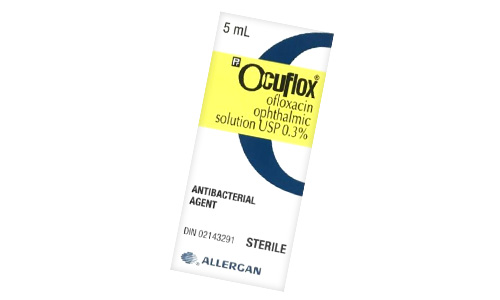Ocuflox Prescribing Information
Ocuflox is the brand name of a prescription medication called ofloxacin ophthalmic solution. It is an antibiotic eye drop used to treat eye infections caused by susceptible bacteria. Ofloxacin is a fluoroquinolone antibiotic that works by inhibiting the growth of bacteria.
Ocuflox is commonly prescribed for conditions such as conjunctivitis (pink eye) and corneal ulcers.

Uses of Ocuflox
Ocuflox is primarily used to treat and manage various eye infections caused by susceptible bacteria. Some common uses include:
- Bacterial Conjunctivitis (Pink Eye): Ocuflox is often prescribed to treat bacterial conjunctivitis, a common eye infection characterized by redness, itching, discharge, and discomfort in one or both eyes. It helps eliminate the bacteria causing the infection and alleviates the associated symptoms.
- Corneal Ulcers: Corneal ulcers are open sores on the cornea, typically caused by bacterial infections. Ocuflox can be used to treat these infections to prevent them from spreading and causing further damage to the eye.
- Bacterial Keratitis: Bacterial keratitis is an infection of the cornea that can result from injury, contact lens use, or other factors. Ocuflox may be prescribed to treat this condition and prevent vision-threatening complications.
- Prevention of Post-Surgery Infections: In some cases, Ocuflox may be used prophylactically (as a preventive measure) to reduce the risk of bacterial infections following eye surgery, such as cataract surgery.
It's important to note that Ocuflox is specifically designed for bacterial eye infections and will not be effective against viral or fungal eye infections.
Dosage
The dosage of Ocuflox can vary depending on the specific eye infection being treated and the instructions provided by your healthcare provider. Generally, the typical dosages for various eye infections are as follows:
Bacterial Conjunctivitis (Pink Eye):
- For adults and children: Instill 1 to 2 drops into the affected eye(s) every 2 to 4 hours while awake, for the first 2 days.
- After the initial 2 days, reduce the dosage to 1 to 2 drops every 4 to 6 hours for the next 5 days.
Corneal Ulcers and Bacterial Keratitis:
- For adults and children: Instill 1 to 2 drops into the affected eye(s) every 30 minutes to 2 hours while awake, during the first 2 days.
- After the initial 2 days, reduce the dosage to 1 to 2 drops every 4 hours for the next 5 days.
Prevention of Post-Surgery Infections:
The dosage and duration of use for surgical prophylaxis may vary depending on the specific surgical procedure. Follow your surgeon's instructions carefully.
It's crucial to wash your hands thoroughly before applying the eye drops. Tilt your head back, look upward, and pull down your lower eyelid to create a small pocket. Place the prescribed number of drops into the pocket without touching the dropper to your eye. Close your eyes gently for a moment to allow the medication to spread evenly.
If you are using other eye medications, wait at least 5 minutes between applying different types of eye drops.
Make sure to complete the full course of treatment, even if your symptoms improve before you finish the medication. If you miss a dose, apply it as soon as you remember, unless it's close to the time for your next dose. In that case, skip the missed dose and continue with your regular dosing schedule.
Side Effects of Ocuflox
Ocuflox can cause side effects in some individuals. Common side effects may include:
- Eye Irritation: Temporary burning, stinging, or discomfort in the eyes is a common side effect when using Ocuflox. This usually subsides shortly after application.
- Redness: Your eyes may appear red or bloodshot after using the eye drops. This is typically mild and temporary.
- Blurred Vision: Some people may experience temporary blurred vision immediately after applying the eye drops. Avoid activities that require clear vision until your vision returns to normal.
- Taste Alterations: You may notice a temporary, unusual taste in your mouth after using Ocuflox eye drops. This taste disturbance is typically mild and brief.
- Watery Eyes: Increased tearing or watering of the eyes can occur in response to the eye drops.
- Eye Itching: In some cases, mild itching of the eyes may occur.
- Foreign Body Sensation: You may feel like there is something in your eye, such as a foreign body or grittiness.
- Eye Discharge: A mild, temporary discharge from the eyes may occur.
These side effects are generally mild and short-lived. However, if you experience any of the following less common but more severe side effects, stop using Ocuflox and seek immediate medical attention:
- Severe Eye Pain: If you experience severe eye pain or discomfort that does not improve after using the eye drops, discontinue use.
- Eye Swelling: If you notice significant swelling of the eyelids, face, or other allergic reactions (such as hives or rash), discontinue use and seek medical help.
- Vision Changes: If you experience any changes in vision, such as sudden vision loss, blurred vision that doesn't improve, or any other significant vision disturbances, contact your doctor immediately.
- Eye Inflammation: Rarely, prolonged use of Ocuflox can lead to eye inflammation or worsening of an eye infection.
Interaction with other drugs
Ocuflox is an antibiotic eye drop primarily used to treat bacterial eye infections. While it is applied topically to the eye and has limited systemic absorption, there is still a possibility of drug interactions, particularly when using other eye medications or systemic medications. Here are some important points to consider regarding drug interactions with Ocuflox:
- Eye Medications: Wait at least 5 minutes between applying different types of eye drops or ointments to ensure each medication is absorbed properly.
- Systemic Medications: Although the systemic absorption of ofloxacin from ocular use is minimal, it's still possible for trace amounts to enter the bloodstream. This is unlikely to cause significant interactions with most systemic medications.
- Concurrent Antibiotics: Using multiple antibiotics simultaneously can increase the risk of antibiotic resistance and may not be necessary.
What to avoid while on Ocuflox
When using Ocuflox to treat eye infections, there are several precautions and things to avoid to ensure the effectiveness of the medication and reduce the risk of complications. Here are some important guidelines to follow:
- Contact Lenses: Avoid wearing contact lenses while you have an active eye infection and are using Ocuflox. Contact lenses can trap bacteria and impede the healing process.
- Other Eye Medications: If you are using multiple eye medications, follow your healthcare provider's instructions on the timing and order of administration. Wait at least 5 minutes between applying different types of eye drops or ointments to ensure each medication is absorbed properly.
- Proper Hand Hygiene: Always wash your hands thoroughly with soap and water before applying Ocuflox eye drops. This helps prevent the introduction of additional bacteria into your eyes.
- Avoid Touching Your Eyes: Try to avoid touching your eyes with your fingers, especially if your hands are not clean. Touching your eyes can introduce additional contaminants and potentially worsen the infection.
- Avoid Contaminated Items: Avoid sharing towels, washcloths, or eye makeup with others while you have an eye infection. Additionally, replace eye makeup (e.g., mascara or eyeliner) after the infection has cleared to prevent recontamination.
- Hygiene of Eye Dropper: Keep the tip of the eye dropper bottle clean and avoid touching it to your eye or any other surface. Replace the cap securely after each use.
- Driving and Activities: Ocuflox may temporarily cause blurred vision immediately after application. It's advisable to avoid activities that require clear vision, such as driving, until your vision returns to normal.
- Alcohol and Tobacco: There are no known specific interactions between Ocuflox and alcohol or tobacco. However, it's generally a good idea to minimize alcohol consumption and avoid smoking when you have an eye infection or are using any medication to promote overall health and healing.
- Compliance: Complete the full course of treatment, even if your symptoms improve before the medication is gone. Stopping the medication prematurely may allow the infection to persist or recur.
Contraindications of Ocuflox
Contraindications are specific situations or conditions in which a medication like Ocuflox should not be used due to the potential risks outweighing the benefits. Contraindications may include:
- Hypersensitivity or Allergy: If you have a known hypersensitivity or allergy to ofloxacin or any other ingredients in Ocuflox, you should not use this medication. Allergic reactions can range from mild skin reactions to severe anaphylactic reactions.
- Tendon Disorders: Ofloxacin, which is the active ingredient in Ocuflox, is a fluoroquinolone antibiotic. Fluoroquinolones are associated with an increased risk of tendonitis and tendon rupture. If you have a history of tendon disorders or have experienced a tendon-related issue with a fluoroquinolone antibiotic in the past, you should avoid using Ocuflox.
- Children Under Certain Ages: The safety and efficacy of Ocuflox in children under specific ages may not be well-established for certain conditions.
- Contact Lens Use: Ocuflox should not be used while wearing contact lenses, as it can interact with the lenses and may cause discomfort. Consult your eye doctor for guidance on when it is safe to resume wearing contact lenses.
- Specific Eye Conditions: In some cases, there may be specific eye conditions or situations where Ocuflox is not recommended.
Pregnancy and Ocuflox
While Ocuflox is an eye drop medication, and its systemic absorption is minimal when applied topically to the eye, it's still important to weigh the potential risks and benefits, especially during pregnancy.
Here are some key points to consider regarding the use of Ocuflox during pregnancy:
- Minimal Systemic Absorption: The systemic absorption of ofloxacin from topical eye drops is generally very low. This means that only a small amount of the medication is likely to enter the bloodstream, reducing the potential for systemic effects on the developing fetus.
- Risk-Benefit Assessment: The decision to use Ocuflox during pregnancy should be based on a careful assessment of the potential risks of the untreated eye infection versus the potential risks associated with the medication. Untreated eye infections can lead to complications, so effective treatment may be necessary to prevent further problems.
- Trimester-Specific Considerations: Some doctors may have preferences regarding the timing of medication use during pregnancy. They may suggest avoiding certain medications during the first trimester when fetal organ development is most critical.
- Breastfeeding: While the systemic absorption of ofloxacin is minimal, it's important to consider whether there are any potential risks to the nursing infant.
» Drug Uses (format pdf, 0.2 Mb)



